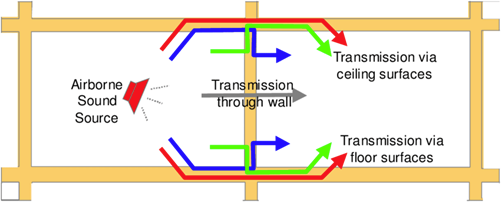Architectural acoustics deals with the way sound behaves within some environment, such as a house, building, school, among others. And even if you are not an expert in acoustics, you need to know this concept.
This is because architectural acoustics are directly related to the comfort of each environment and its use.
Therefore, everyone involved with construction should keep these concepts in mind. Architects, engineers, suppliers and buyers need to be mindful of architectural acoustics.
What is architectural acoustics?
An architectural acoustics project extracts the full sonic potential of any environment. For this, a series of analyzes and tests are carried out on each element of the building. The main objectives are:
- Isolate unwanted external noise.
- Ensuring adequate acoustic comfort in each environment.
The goals depend a lot on the function of each environment. For example, in an apartment, you may want to isolate the sounds from upstairs. On a facade, attenuate street noise. In an auditorium, the design must facilitate the propagation of sound from the stage, and so on.
Ceiling connections, positioning of walls and furniture, and materials used in the work: each of these points interferes with the way the sound behaves.
How does sound propagate within an environment?
Knowing how sound travels is important for understanding noise sources and how to better prepare your environment for them.
Have you ever seen how a speaking act works? If so, have you noticed that it vibrates while playing the music.
This is because, basically, noise is the vibration of air particles. This vibration generates a pressure wave that is picked up by our eardrum.
The noise passes through solid parts, like walls, because when these pressure waves hit the wall, it vibrates and the sound plays on the other side.
What are the main noises inside a building?
Following this logic, some of the common examples of noise inside buildings are:
- Airborne noises: are those propagated through the air. They are the ones that come from the outside and pass through walls, slabs or facades, for example.
- Aerial regarding the form of propagation (transmission):
- can be direct (noise hits one side of the wall and is transmitted to the other).
- or secondary (noise hits a wall and causes other connected structures, such as the ceiling, floor and adjacent walls to vibrate as well), as shown in the figure below.
- Aerial regarding the form of propagation (transmission):
- Impactful: when the upstairs neighbor walks in the house wearing heels and you hear the noises of “knock”, “knock”, for example.

How do you know if the acoustics are good?
In Brazil, the NBR 15575 standard establishes some quality criteria for the acoustic performance of constructive configurations.
It regulates the acoustic performance of the building as a whole: noise from walls, slab and floor acoustic insulation, floor vibration insulation, noise generated by hydraulic systems, among others.
The standard defines three levels of quality: minimum, intermediate and superior. Knowledge in architectural acoustics is necessary to reach the higher level.
How to have the best level of quality in architectural acoustics
As we explained earlier, there are some main noise sources inside buildings and each of them requires specific actions. Here are the best practices for each of them:
Air noise between walls
In this case, normally the acoustic performance depends on the mass effect of the wall. The greater the inertia, the better the acoustic performance of the room. It is possible to use double walls for better performance as long as they are well sized and have some kind of acoustic material inside.
Some construction details often go unnoticed and can facilitate the propagation of noise from one side of the wall to the other. The passage of conduits and the passage of electrical boxes, for example, can decrease performance.
When building, it is important to be aware of the ways in which sound propagates, which can be direct or indirect.
Direct transmission is from one side to the other. Therefore, the lighter the wall, the greater the vibration. And in turn, the higher the vibration, the higher the noise transmission level.
Secondary, or flank transmission, focuses on a wall connected to a ceiling, floor or other walls. In this case, the vibration of all other structures also influences the propagation of sound.
Therefore, individually reinforcing the walls does not always have such a satisfactory result. Before taking action, it is necessary to know this structural feature to define the best action plan.
Facade aerial noise
The aerial transmission of noise in the facade shares these elements, but it has one more variable: it usually has a sliding door, a shrimp door, or others that require two parts to fit together.
Therefore, it is important to be aware of leaks: any gap between the frame and the wall, or between the door leaves, the door rail and the frame, among others, degrades the sound insulation capacity of the environment.
In these cases, it is recommended to use a thicker glass, from 6 to 9 millimeters, as long as the frame is well planned. Even, in some cases, the gaps can determine the difference between a minimum or intermediate noise quality.
Impact noise
When the upstairs neighbor makes noise, he often doesn’t even notice. And this is natural: the sound is louder even for those below. The normalized impact noise test helps to identify if it is occurring.
There are five pistons with standardized weights that are lifted and dropped by a machine to a height of about 12 centimeters. They keep hitting the structure alternately. A meter picks up this noise and helps determine where and how loud it occurs.
In terms of construction, the worst structure is having a slab, subfloor and laying ceramic flooring. Normally, this type of construction cannot even reach the minimum level of NBR 15575.
The ideal is to insert an acoustic insulation material between the floor and subfloor. It is a rubbery material, which looks like foam, mounted on top of the subfloor. It must cover the entire area, without gaps or seams. The function of this material is to eliminate the contact of the subfloor with the other structures.
In fact, this acoustic material must be included even in suites or bathrooms close to the rooms. Otherwise, the noise will be transmitted to the slab through the bathroom and the acoustic performance will drop.
Sound insulation materials
Sound insulation materials help reduce perceived levels of noise in environments. There are several types of materials, in addition to the example we mentioned above.
There are even floors that already have layers of foam for the moment of assembly.
Based on our experience at Vibroacustica, laminate floors mounted on top of flexible mats have good results.
When the assembly is done on ceramic floors, it is necessary to be careful in the assembly, and in some cases even use metal mesh to structure the subfloor.
It is necessary to pay attention to the sensitivity of the chosen material, as any leakage decreases performance. In some cases, the transport by wheelbarrow itself impairs the quality. Therefore, it is important to pay attention to possible points of impact.
As you have seen, there are several variables that influence performance. Therefore, if you need support in architectural acoustics, contact Vibroacustica, a specialist in acoustics and vibrations.
NVH Specialists
Vibroacustica is specialized in NVH analysis and simulations in several areas, in addition to having expertise in compressor projects for national and international customers.




